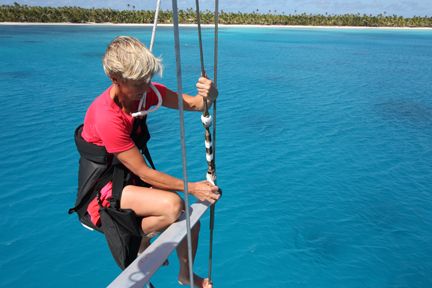Tuning the rig of a boat is one of the necessary — and unpleasant — tasks that must be done to achieve good boat performance. In an un-tuned boat, the mast bends in odd ways, and this in turn causes the sails to set badly. By contrast, on a well-tuned boat, the rig bends in a controlled fashion, allowing the sails to do their best. For this reason, an avid racer will be constantly fiddling with the tune of his boat, while most of us do it once during commissioning, and that may suffice.
The first thing to realize is that for a mast to stand well, it should not be straight when it’s in a static, no-load situation. This was something I realized nearly 30 years ago when conventional advice was to tune rigs so that masts were indeed straight when static, and while that advice is still sometimes given, most of the sailing world has realized that a controlled static bend is needed.
The problem with a statically straight mast is that when loaded, it is too easy for the mast to invert, or bend backward. This can happen when the boat is beating in a seaway or reaching with the spinnaker pole up. Most mast sections can accommodate a significant amount of forward bend without failure, but very little aft bend.
For additional, detailed advice on standing rigging, purchase Nigel Calder’s Boat Owner’s Mechanical & Electrical Manual from Practical Sailor’s online bookstore.










































